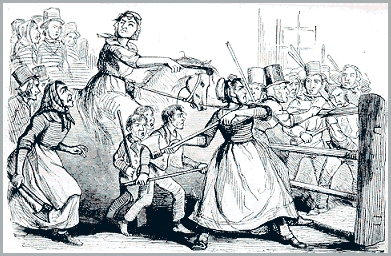
*
Australians are not taught about Chartism. In order to counter this neglect and understanding that many people prefer history not in a plain brown paper wrapping but encased in a ‘silvered wrapping of entertainment’, events and facts were researched, then supplemented with relevant art forms and arranged in a form suitable for a staged show. By utilising format and content akin to Chartist meetings held in 1838-48, material has been assembled for a show comprised of scripted facts, songs, dances, images and cartoons using a format labelled ‘Folk Doco’ and named ‘When Democracy Danced in Workers’ Boots’.
Next year ‘Magda Productions‘, a performing Arts group based in Brisbane will be staging the show. Magda’s Productions have given many successful performances of my earlier show, ‘Dames & Dare-devils for Democracy’ in Brisbane. COVID permitting, the two shows linked by the real-life character of Emma Miller, the suffragist whose life story introduced me to Chartism may undertake a short tour.
This is the song I wrote as an overture for ‘When Democracy Danced in Workers’ Boots’ with booted tap dance interludes instead of a chorus:
WHEN DEMOCRACY DANCED IN WORKERS’ BOOTS © Phyl Lobl 2020
Workers wearing working boots, trodden down through centuries,
Rebels wearing working boots stepping up through time,
Fired by Tom Paine’s ‘Commonsense’ and the works of Thomas Spence,
Tommy Muir caused offence in the name of Justice.
Stepped up to dance, stepped up to dance, stepped up to dance for Justice.
( Booted Tap- Dance Interlude )
Need for action in their bones, for a changing century.
Call of freedom in their tones, echoing through time.
Asked of woman and of man ‘Pass the torch on when y’ can’,
Leading to a Chartist Plan in the name of Justice.
Stepped up to dance, stepped up to dance, stepped up to dance for Justice.
( Booted Tap- Dance Interlude)
In the convict boats and chains, victims of the century,
Radicals and Chartists came, serving years of time,
Starry skies Down-under blazed where William Cuffay’s work was praised,
Where Eureka’s flag was raised, raised by Chartist Justice.
Raised up to dance, raised up to dance, raised up to dance for justice.
( Booted Tap- Dance Interlude)
CONCLUSION
After a long journey of research and creation, some questions remain:
Why is there a paucity of documentation and discourse on Chartism in Australia?
For how long will our history curriculums continue to be short-changed on reality?
This missing Chartist history is linked to another missed history, the history of the
Australian indigenous peoples and the effect of colonisation on their lives and their rights.
These two missed histories are linked, because without the growth of democracy in Australia, recognition of the gross injustice inflicted on, and negligence of indigenous people could not have begun to be addressed, even though there is still a long way to go. The ‘Uluru Statement from the Heart’ could lead us.
There is a fragile fabric of pseudo civilisation that covers shaky spines, mediocre minds, and hardened hearts. It could be shed, and instead, wearing workers’ boots and stepping in the path of Chartists, knowing that they gave us a strong foundation for Democracy, we could see their heritage valued as part of our national identity. Hopefully the Australian community can repay the Chartists by electing people who share and practise such ideals.
The closing song in the new show is John Warner’s fine song ‘Bring Out the Banners’; a suitable line to end this article is:
’How dare we lose what they have won?’
SOURCES USED
In pursuing this research towards the creation of her ‘folk doco’, Phyl consulted a wide variety of standard and other sources. She also spoke with many people across the country.
Australian
E-books
Tony Moore, Death or Liberty: rebels and radicals transported 1788 -1868
Peter Fitzsimons, Eureka: the unfinished revolution
Anne Henderson, Joseph Lyons: the peoples Prime Minister
Judith Brett, The enigmatic Mr Deakin
Judith Brett, From secret ballot to democracy sausage
K S Inglis, This is the ABC
Hard copies
Isobel Downing, Ballarat Reform League inc. (computer printout)
John Molony, Eureka and the prerogative of the people
Martin Hoyle, William Cuffay: the life and times of a Chartist leader
Bob O’Brien, Massacre at Eureka: the untold story
Elizabeth Morrison, David Syme: a man of the Age
Other Media
Tasmanian Grassroots Union Choir, Cuffay and the brother slaves – CD
Internet searches on Chartist convicts, eight-hour day, shearers strike, Labor movement, miller, Federation, Henry Parkes …
British
E-books
Edward Boyle, Roger Lockyer, ‘Chartism’ (seminar studies)
Thomas Carlyle, Chartism
Julius West, A history of the chartist movement
Thomas Paine, The rights of man (illustrated)
Hard copies
James Epstein, The lion of freedom: Feargus O’Connor and the Chartist Movement
Mike Leigh, Peterloo
Other Media
Radical Tea Towel Co (UK), Tea towel – Six points of the people’s charter
The life and struggles of William Lovett, facsmile of original, British Library DVD
Numerous internet searches






